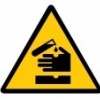
Oxalic acid easily removes traces of iron oxides on glassware as well as on metal.

Quote: Originally posted by weiming1998  |

Quote: Originally posted by Antiswat  |
Quote: Originally posted by weiming1998  |
Quote: Originally posted by weiming1998  |
Quote: Originally posted by MrHomeScientist  |
Quote: Originally posted by Antiswat  |
| Quote: |
Quote: Originally posted by bob800  |

 under the kitchen sink. I wet my hands under the tap and scrubbed them with the
coarse powder, then rinsed thoroughly. The base completely removed every trace of primer. The skin felt slippery afterward; if I recall correctly
this is caused by the moderate/strong base disrupting cell membranes.
under the kitchen sink. I wet my hands under the tap and scrubbed them with the
coarse powder, then rinsed thoroughly. The base completely removed every trace of primer. The skin felt slippery afterward; if I recall correctly
this is caused by the moderate/strong base disrupting cell membranes.

 Have you tried the tried and true NaOCL yet on the stain?
Have you tried the tried and true NaOCL yet on the stain?
Quote: Originally posted by woelen  |
Quote: Originally posted by zts16  |
Quote: Originally posted by Oscilllator  |

Quote: Originally posted by zts16  |

Quote: Originally posted by blargish  |
 )
) ).
).Quote: Originally posted by Melgar  |
Quote: Originally posted by CobaltChloride  |
Quote: Originally posted by Mr. Rogers  |
Quote: Originally posted by Sulaiman  |

Quote: Originally posted by JJay  |
Quote: Originally posted by monolithic  |
Quote: Originally posted by CobaltChloride  |
Quote: Originally posted by Antiswat  |
 . I
guess that will forever be a testament to secondary containment for anything that has the possibility to boil over...
. I
guess that will forever be a testament to secondary containment for anything that has the possibility to boil over...Quote: Originally posted by itsallgoodjames  |